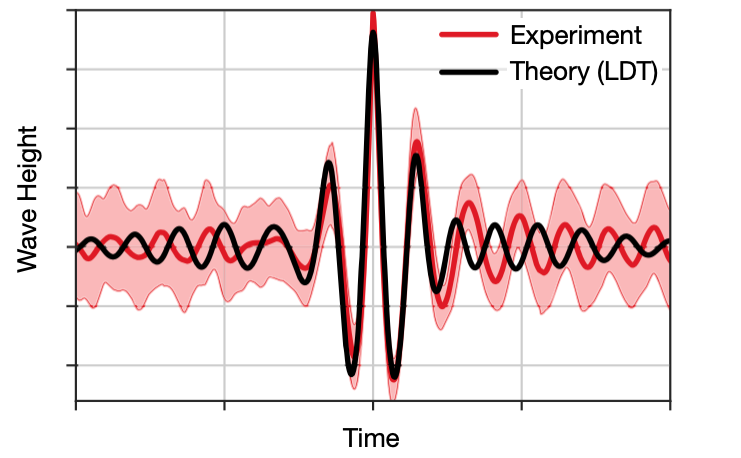The Mathematics of Rogue Waves
Rogue waves are ocean waves of extreme height, often many times the height of the surrounding sea. Long considered a figment of sailors’ imaginations, such waves are now recognized to be real, and a serious threat for boats and naval structures. Unlike Tsunamis — giant waves caused by undersea earthquakes — or large waves seen breaking on shore in a storm, rogue waves may appear out of nowhere in otherwise calm conditions. This makes them hard to predict and a challenge to understand scientifically. A group of mathematicians*, including from the Warwick Mathematics Institute, have found a new way to tackle the problem from the perspective of probability theory, putting the creation of rogue waves into a unified theoretical framework."There are many ways of creating a typical ocean wave", explains Tobias GrafkeLink opens in a new window, "but in contrast, for waves of atypically height, everything must conspire in just the right way. This is what makes rogue waves predictable". This 'Goldilocks'-effect lies at the centre of large deviation theory (LDT)Link opens in a new window, a subfield of probability theory. Extremely rare events are describable by focusing on their most likely occurrence, instead of attempting an exhaustive search of every possible outcome.The mathematics indeed describes the formation of rogue waves in the sea surprisingly well. By concentrating only on the most likely rogue wave scenario, the group was able to not only find the probability of these waves in different sea states, from stormy to calm, but also their overall likelihood of occurring. The theory holds up very well against experimental rogue waves created in a water tank. Taking the 300 highest waves from one of Europe's largest wave experiments — a 270m long wave flume in Norway — the wave shapes as well as the history of their formation line up nicely against the waves predicted by large deviation theory.Of course, mathematicians immediately turn to ways of generalise the abstract framework, and apply it to other areas of application. Grafke is particularly excited to tackle extreme events in weather prediction and climate science with it, with current projects addressing for example the breakdown of the Gulf Stream in the North Atlantic.
*The group consists of collaborators: Giovanni DematteisLink opens in a new window (RPI), Tobias GrafkeLink opens in a new window (Warwick), Miguel OnoratoLink opens in a new window (Turino), and Eric Vanden-EijndenLink opens in a new window (NYU).
WMI Magazine staff
Published 12 October 2023
Rogue waves in experiments closely resemble the specific wave shapes obtained in the mathematical framework of large deviation theory (LDT).
Technically the wave forms from LDT are hydrodynamic instantonsLink opens in a new window — minimizers of an action associated with the random wave model used to describe the system. They can be thought of as the "most likely of the unlikely".
Read more in popular publications:
- National GeographicLink opens in a new window
- Quanta MagazineLink opens in a new window
- Scientific AmericanLink opens in a new window
Read more in the scientific literature:
- "Experimental evidence of hydrodynamic instantons: the universal route to rogue wavesLink opens in a new window", by Dematteis, et al.
- "Rogue waves and large deviations in deep seaLink opens in a new window", by Dematteis, et al.
- "The instanton method and its numerical implementation in fluid mechanics", by Grafke, et al.

